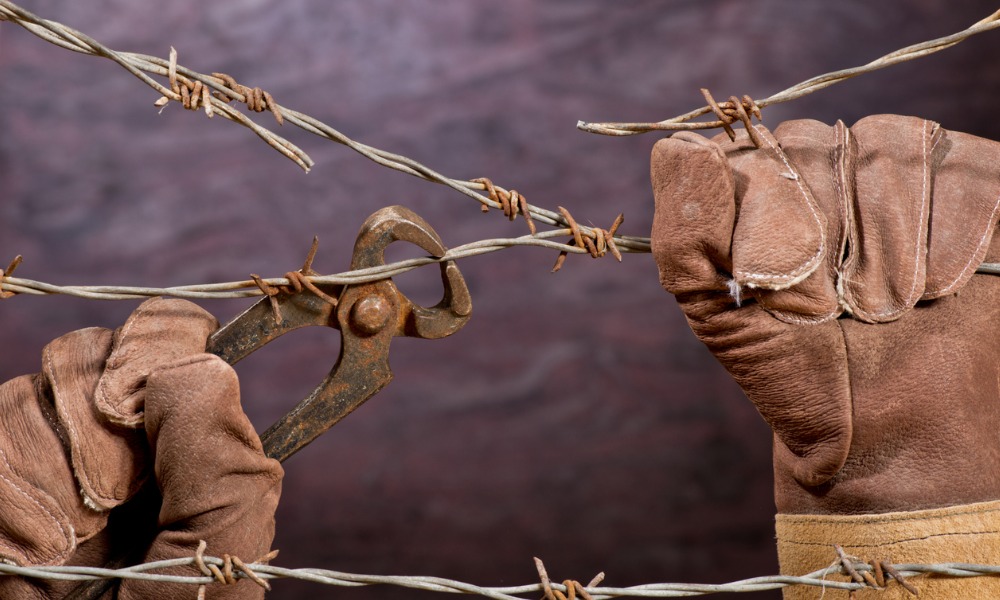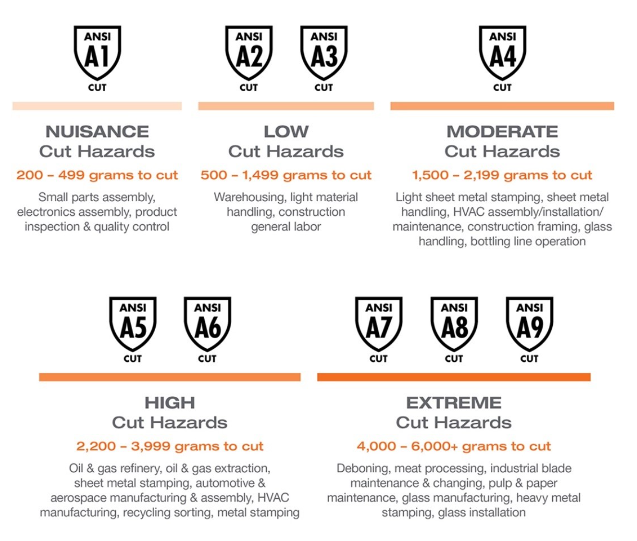Are you looking to equip your company workers with the right cut-resistant gloves? Then this guide on cut-resistant gloves is for you

- What are cut-resistant gloves?
- Why cut-resistant gloves are essential for workplace safety
- What are cut-resistant gloves made of?
- Cut resistance protection levels and their importance
- What is the highest cut-resistant glove?
- Do cut-resistant gloves really work? Some myths on cut-resistant gloves
- Top brands and suppliers of cut-resistant gloves in Canada
- Choosing the right cut-resistant gloves for your needs
In industries where workers are around cutting tools or sharp objects, nearly a third of workplace injuries are cuts to their hands. The main cause of these injuries is workers wearing the wrong type of gloves, or worse, wearing none at all.
Fortunately, there’s an array of cut-resistant gloves you can choose from and equip your workers and staff. But on the flipside, the selection can be so diverse that trying to choose an effective set of gloves can be overwhelming. That’s why Canadian Occupational Safety offers this guide to help you choose the right cut-resistant safety gloves.
We’ll provide insight into crucial features of these gloves, like the different levels of cut resistance, their materials, and role in your workers’ everyday tasks. This article will also answer vital questions and dispel some myths about cut-resistant gloves, like:
- Are cut-resistant gloves cut-proof?
- Are cut-resistant gloves also puncture-resistant?
- How are cut-resistant gloves rated?
Read on for a complete primer on cut-resistant gloves.
What are cut-resistant gloves?
Cut-resistant work gloves are a type of personal protective equipment (PPE) specifically designed to protect hands from cuts or lacerations. These injuries are caused by contact with various cutting machines, equipment, tools, or items with sharp edges like:
- knives
- blades
- metals
- glass
- ceramics
Depending on your industry, cut-resistant gloves can be a part of your company’s overall strategy to ensure workers’ safety in the workplace.
These days, cut-resistant gloves are made of composite materials that are typically a combination of stainless-steel mesh, fiberglass, and synthetic high-performance yarns. Some cut-resistant gloves may also be made partly of leather to improve the dexterity and comfort of the wearer.
Why cut-resistant gloves are essential for workplace safety
Cut-resistant gloves are vital to workplace safety since injuries to workers’ hands can be one of the unkindest cuts of all. According to a 2020 study, workplace injuries impact productivity, not to mention workplace safety and morale.
The 2023 statistics of WorkSafeBC shows that there were an estimated 4.15 million days of work lost due to work-related incidents and disease. Of these work-related injuries, 4,932 were cutting incidents. Having PPEs like cut-resistant gloves is essential not only for your employees’ safety and well-being, but also to your company’s bottom line.
What are cut-resistant gloves made of?
Thanks to advances in manufacturing and synthetic fibre technology, cut-resistant gloves are made mainly of two very tough materials:
1. High Performance Polyethylene (HPPE) – This is a material that is soft and cool for the wearer, providing more dexterity. HPPE allows for a higher tactile feel than para-aramid, but melts when exposed to heat.
2. Para-aramid – This is a naturally flame-resistant material; para-aramid is a dense fiber that is warmer than HPPE.
Cut-resistant safety gloves made only with HPPE or para-aramid can offer up to ANSI Level A3 cut resistance (more on this later). But thanks to modern manufacturing technology and engineered yarns, other strong materials can be added for higher cut protection, improved dexterity, comfort, and durability. These added materials can include one or more combinations of the following:
|
Material |
Feature |
|
steel, metal wire, or fibreglass |
enhance cut protection at the cost of lesser dexterity |
|
nylon and polyester |
can provide added comfort and dexterity |
|
cotton |
can increase wearer comfort |
Stainless steel or metal wire can also be the sole material for cut-resistant work gloves. If these gloves are made only with metal, they are called chainmail. These are generally used in heavy-duty food processing work, like deboning meat or filleting fish.
Cut resistance protection levels and their importance
Now that you have a better idea of what cut-resistant gloves are made of, how do you choose the right one for your workforce? The standard practice is to find the appropriate gloves that have the cut resistance protection levels your workers need to lessen the risk of nasty cuts while doing their jobs.
These cut resistance protection levels are prescribed by the American National Standards Institute (ANSI). To determine these cut protection levels, ANSI uses specific test methods on safety gloves.
These tests rate the cut protection levels of gloves by applying certain amounts of force on a blade used to cut through the glove or its materials. For cut-resistant safety gloves, the most recognized standard for assigning its cut resistance rating is the American National Standard for Hand Protection Classification ANSI/ISEA 105. This same standard sets the stage for the ASTM F2292-15 test method for quantifying safety gloves’ cut resistance.
What is the highest cut-resistant glove?
There are nine different cut resistance levels ranging from A1 to A9, with A9 having the highest cut resistance.
These levels correspond to the varying levels of cut resistance in terms of the weight applied to a blade that cuts through different kinds of glove material. The weights range from a mere 200 grams to 6000 grams or more.
Here is an illustration from OHS Canada showing the different cut resistance levels and the industries/jobs that apply:

Low resistance cut levels of A1 through A3 can protect against “minor nuisance” cut hazards in low-risk worksites or environments. This can include working in warehouses where employees use scissors or box cutters to pack and ship merchandise.
Gloves with high cut resistance ratings of A4 and higher are better suited to work environments where employees have higher risks of getting their fingers or hands cut. This can include jobs that involve:
- handling sheets of glass or metal
- metal pressing
- cutting construction materials
Jobs that require the use of heavy machinery and heavy assembly tasks would likewise do well with gloves that have A4 or higher-rated cut resistance.
Ultimately, your decision on which cut-resistant work gloves to purchase depends on two factors:
- the nature of the work
- the potential hazards that workers and staff must deal with
If you need a quick reference as to which cut resistance ratings fit which jobs or industries, here’s a short video that gives an overview. Also, consider the coatings of these gloves; some have polyurethane or nitrile for better grip. And depending on the task, you can also choose gloves that provide some impact and abrasion protection.
Visit our Readers’ Choice Awards for the best safety suppliers in Canada – the list includes manufacturers of safety gloves.
Do cut-resistant gloves really work? Some myths on cut-resistant gloves
In your quest to look for and buy the right cut-resistant safety gloves, you may encounter a few old wives’ tales about their protective capabilities and durability. When it comes to picking the right cut-resistant gloves, here are some popular myths that you should be wary of:
Myth: cut-resistant also means cut proof
As the name suggests, “cut-resistant” only means the gloves provide some resistance to cutting. This doesn't make you completely safe from being cut.
It’s important to inform those who will be using these gloves of this myth, so they do not misinterpret the cut resistance and deceive themselves into thinking they can do virtually any hazardous task. There is simply no such thing as a “cut proof” glove.
Myth: cut-resistant gloves are also puncture-resistant
Cut-resistant gloves do not provide 100% protection against puncturing injuries from sharp objects. Depending on factors like the cut resistance level of the gloves, the sharpness of the object and the force of the blow, a cut-resistant glove may not completely prevent a puncture wound.
Myth: you cannot clean cut-resistant gloves
It’s not true that cut-resistant gloves cannot be cleaned. You can use plain soap and water to clean your cut-resistant safety gloves, although some models may have special cleaning instructions. Check with the manufacturer’s instructions to see if this is the case. Some gloves made with Kevlar cannot be cleaned with chlorine-based bleach; you may have to use other products that are less harsh.
Myth: the higher the cut resistance rating, the better it is for you
When you run down the list of the different cut resistance levels, it may seem like getting gloves with the highest rating possible would be the best choice. This is a mistake.
The best glove for you and your company is the one that has the right cut resistance for the specific cutting hazards you encounter. For instance, a worker who uses a box cutter once a day doesn’t need the same protection as someone who works in a meat processing plant eight hours daily. Always match the gloves’ cut resistance level with the type of job and cutting hazards your workers have.
Top brands and suppliers of cut-resistant gloves in Canada
If you’re wondering which specific brands or models of cut-resistant work gloves to look for, here are some options:
1. Cordova Commander Impact
This robust cut-resistant glove offers one of the highest levels of protection. Made of high-performance polyethylene (HPPE), these gloves have added steel and/or glass fibers for unmatched cut resistance compared to gloves made with HPPE only.
The Cordova Commander Impact cut-resistant glove offers level A7 cut protection. The glove features a 13-gauge, hi-visibility yellow HPPE/Glass/Steel fiber composite shell. Its palm is composed of a two-layer, red sandy nitrile coating for increased grip. The Cordova Commander also offers impact protection, and its hook and loop closure offers greater retention.
2. Bob Dale ArkTek Goatskin Gauntlet Cut/Impact Gloves
Brasco Safety released the Bob Dale ArkTek Goatskin Gauntlet Cut/Impact Gloves in early 2024, and those in heavy industry can benefit greatly from their durability and comfort. These gloves are of a premium grain goatskin construction that gives its wearer great comfort without sacrificing durability.
Its construction is reinforced with a Kevlar® liner for cut and abrasion resistance. TPR guards protect from impact forces, while a reinforced thumb saddle area and foam-padded palm give extra protection.
These impressive-looking gloves in hi-visibility white meet the standards for ANSI/ISEA 105 and offer level 4 cut and puncture resistance.
3. Showa XC810
These industrial cut-resistant gloves from Showa boast of a unique feature: offering high cut resistance while also being breathable. One of their newest products, the XC810, is a versatile glove that offers excellent grip, and superior tactility, thanks to its 18-gauge HPPE construction. The glove is an optimal combination of dexterity and protection, with its A4 level of cut-resistance.
The Showa XC810 is ideal for automotive, construction, glass, and mechanical applications, and excels in light assembly, maintenance, repair, and component assembly. Its form-fitting, HPPE reinforced, microporous nitrile coating and embossed grip enhance durability and flexibility for the wearer.
4. Midas Safety Nylon PU 2.0
This cut-resistant glove from Midas Safety is an indispensable tool for workers who:
- work in an assembly line
- do gardening
- move boxes
- handle materials
- work with small parts
Don’t let its simple appearance fool you; it has a cut resistance level of 4, and an abrasion resistance level of 4 (EN 388:2016 level 4).
Not only can this glove protect the wearer from cuts and abrasions, but it can also be used in wet, oily, and dry conditions. Thanks to its touchscreen capabilities, workers will surely keep wearing them for the entirety of their shift.
Choosing the right cut-resistant gloves for your needs
These are only a small sample of the sort of cut-resistant gloves on the market. You can try these models or explore the full range of gloves from these brands, but don’t limit yourself – do your due diligence and research on other reputable names in safety gloves. You can pore over our hand protection section to see the other glove brands and models available.
While cut-resistant safety gloves do not offer 100% protection, it is no reason to do away with them either. The real purpose of cut-resistant gloves is to lessen the severity of any cutting injury. A pair of cut-resistant gloves can mean the difference between getting surgery or putting on a band-aid to cover up a cut.
Which of the cut-resistant gloves we featured do you plan to buy for your workforce? Let us know in the comments below





